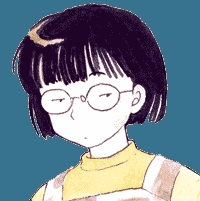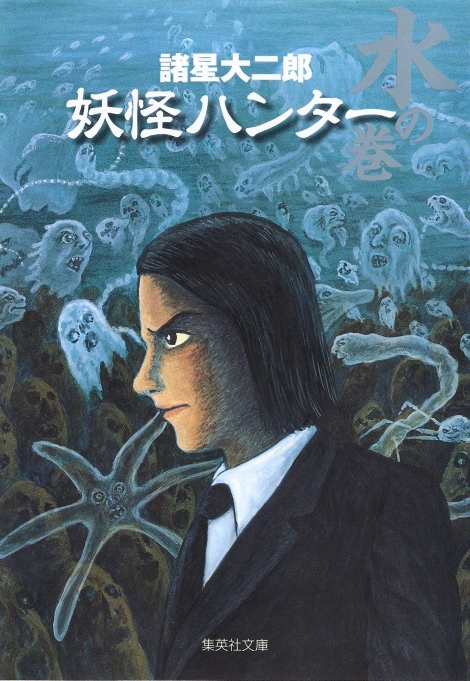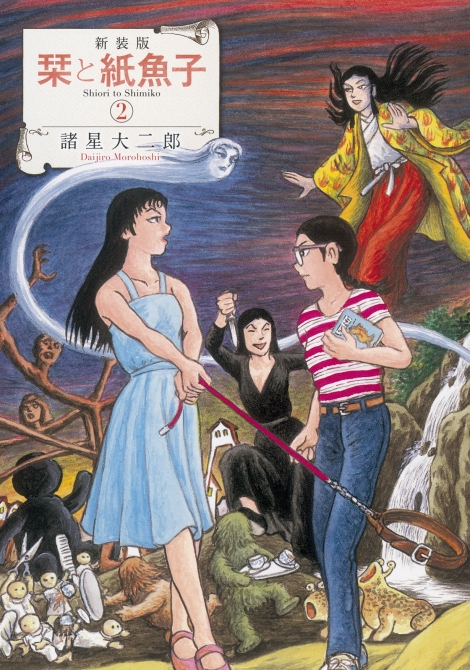

Daijiro Morohoshi
Orbiting Rumic World - File 3
By Harley Acres
Daijiro Morohoshi is often said to be a mangaka’s mangaka.

In order to fully understand Rumiko Takahashi and her contributions to the field of manga as a whole, you have to understand her place within that field, and that involves examining her influences, peers and followers. This is what Orbiting Rumic World is dedicated to exploring.
Daijiro Morohoshi is a creative force in Japan, and yet he is almost unknown in many English-speaking manga circles. Morohoshi is often said to be a mangaka’s mangaka due to how wide his circle of influence has become. [1] Despite the plaudits of so many in the industry his work has not made a significant impact aboard. As of 2022 he has had no work officially published in English and while horror artists such as Junji Ito are championed more and more in the West, and older horror maestros such as Kazuo Umezu are finally getting their due, Morohoshi remains in the shadows of the English-speaking manga world.
Born in Karuizawa in 1949, Morohoshi grew up in the Adachi district of Tokyo in the shadows of the “Ghost Chimneys”, towering thermal stacks belonging to the Senju Thermal Power Station whose nickname comes from their ominous silhouette on the horizon and their unique diamond arrangement which caused the thermal power stations’ smokestacks to appear as two, three or four massive towers depending on the angle they were viewed from passing trains. It is in this surreal landscape that Morohoshi’s childhood imagination began to grow. [2]
Osamu Tezuka stated that Daijiro Morohoshi was the only artist he could not imitate

Morohoshi began his adult life as a civil servant before beginning his career in manga in 1970. It was in 1974 that he had his breakthrough upon winning the seventh Tezuka prize for Seibutsu Toshi (生物都市/The Living City). [3] The story is a science fiction horror tale about an infection that was brought back by astronauts from Jupiter’s moon, Io. Slowly the plague absorbs machines and people, turning them into a single hive-minded organism.
Unlike the grotesque horrors of Junji Ito and Kazuo Umezu, Morohoshi’s work is more akin to that of H.P. Lovecraft, it is an unknowable horror, bizarre and surrealistic. The influence of the European Surrealists of the 1920s and 1930s is apparent in Morohoshi’s manga. His melting city calls to mind the melting clocks of Salvador Dali and the isolated steaming trains in a barren landscape suggest the cryptic works of Giorgio di Chirico. Morohoshi makes these influences plain, a 2020 museum show to celebrate the 50th year of his career featured reproductions of Surrealist paintings by Dali and Rene Magritte hanging next to Morohoshi’s own work. [4]
If his art style is deceptively simple it is also utterly unique. An oft-told story states that Osamu Tezuka, often prone to bragging about his own ability to mimic the style of other manga artists including the detailed drawings of Katsuhiro Otomo, stated that Morohoshi was the only artist he could not imitate. [5] [6] [7] [8] [9] Assistants have been said to be uncertain of how to complete their tasks when working with Morohoshi. [10] His is an idiosyncratic voice in manga for the past five decades.
Hayao Miyazaki has cited Morohoshi as an influence

Daijiro Morohoshi’s first hit was 1978’s Yokai Hunter (妖怪ハンター) which follows former archeology professor Reijiro Hieda during his discoveries of strange creatures. Hieda, like Tezuka’s unlicensed surgeon, Blackjack, has been shunned by the mainstream archaeological community due to his outlandish theories, however his adventures into the unknown prove there are more mysteries in the world beyond the university’s halls that Hieda abandoned. It is from this series that some of his most well-known stories have arisen. Seimei no Ki (生命の木/Tree of Life) is mentioned as drawing on Morohoshi’s influence from Western art where he shows a column of humans rising from a hellish pit into heaven in an illustration said to have been influenced by Tintoretto’s Mannerist painting the Ascension of Christ (1576-1581). [11]
In the 1990s Morohoshi dabbled in shojo manga with Shiori to Shimizu (栞と紙魚子), a tale about two girls and the supernatural events they come across in their otherwise normal town. This manga is more lighthearted than his macabre better known works. It would also eventually be adapted into a live action series in Japan. Uniquely, it is in live action that his work tends to be adapted. Very little of his manga has been made into anime and a single, obscure video game for the Famicom are the only examples of his work spreading to other media. [12]
One of the most unique series by Morohoshi are his Mud Men (マッドメン) stories. The series delves into the life of Kodova, a half-Japanese, half-New Guinian tribesman who returns to his roots as part of the real-life Asaro Mud Men tribe. It is from Mud Men that Hayao Miyazaki drew inspiration for elements for his film Castle in the Sky (the magic word “balse” (baroos) originates from Morohoshi’s manga for instance). [13] Design elements of Princess Mononoke also show Miyazaki’s familiarity with Morohoshi’s work. Hayao Miyazaki has cited Morohoshi as an influence on Nausicaä of the Valley of the Wind which he once stated he wished Morohoshi would have illustrated the manga instead of himself. [14]
Even the seminal Neon Genesis Evangelion (新世紀エヴァンゲリオン/Shinseiki Evangerion) cites Morohoshi has an influence. While no particular story elements were borrowed from Morohoshi, Toshio Okada cites Morohoshi’s Yokai Hunter story “Shibito kaeri” (死人帰り/Return of the Dead), and the aforementioned Seibutsu Toshi (生物都市/The Living City) as influences while Hideaki Anno cites Kage no Machi (影の街/City of Shadows) as something he wanted to capture in Evangelion. [15] [16]
Rumiko Takahashi is a major admirer of Morohoshi’s work

That Rumiko Takahashi would mark herself as a major admirer of Morohoshi’s work is likely no surprise to those familiar with her work Urusei Yatsura. It is from Daijiro Morohoshi that she was inspired to name her lecherous hero “Ataru Moroboshi”. [17] [18] In Morohoshi’s work Adamu no Rokotsu (アダムの露骨/Adam’s Rib) you see the strange monsters which invariably influenced Takahashi’s own Birds of Paradise in Inuyasha. Takahashi is such a fan of Morohoshi that she has written two short stories about her love of his manga and her joy in meeting one of her admired contemporaries. In her tributes to the author she discusses her love of his story Ankoku Shinwa (暗黒神話/Dark Myth) before discussing half a dozen other series and short stories of his that she has loved, even concluding with a discussion of her joy in seeing Morohoshi on the manga themed ManBen television show hosted by Naoki Urasawa. [19] [20]
A common thread that binds Morohoshi and Takahashi are their interest in mermaids. Both have delved into mermaid myths with a melancholy tone and both have discussed with one another their fascination with the topic. Morohoshi writes about various maritime tales in his short story collection Shikaban Gyorui-Zufu (私家版魚類図譜/The Private Atlas of Fish) while Takahashi has explored the themes of unwanted immortality that comes with consuming the flesh of a mermaid in her Mermaid Saga.
In their conversation Morohoshi speaks with Takahashi about how she came up with the horrific nature of her mermaids. Takahashi explains that the initial storyline, “A Mermaid Never Smiles,” came from a desire to subvert expectations. Because mermaids are sea creatures, she desired to set that story in the mountains with mermaids that were more monstrous than what traditional stories depict. Takahashi shares that she did a preview illustration prior to writing the initial story and the challenge of then crafting a story that could live up to this teaser advertisement. Morohoshi responds that the American film director Roger Corman used similar techniques, often filming the trailer for a film in hopes to gain financing to make it. [21]
After fifty years of unknowable horror, perhaps it is finally time for Western audiences to come to know this icon of the uncanny. Perhaps soon the “manga artist among manga artists” will finally have his place on the world stage.
Footnotes
- [1] Naoki Urasawa's Manben NEO. 2020. Season 5, Episode 21, “Daijiro Morohoshi.” Directed by Issei Takiguchi. Aired November 12, 2020 on NHK E Tele.
- [2] Morohoshi, Daijiro. ぼくとフリオと校庭で. Tokyo: Futabasha, 1991.
- [3] "諸星大二郎." Wikipedia.org. August 2, 2022. Accessed December 10, 2022. https://ja.wikipedia.org/wiki/ 諸星大二郎.
- [4] Internet Museum. “三鷹市美術ギャラリー「デビュー50周年記念 諸星大二郎展 異界への扉」.” Museum.or.jp. August 11, 2021. Educational video, 4:27. https://www.youtube.com/watch?v=ZAWLNrV8ym8.
- [5] The anecdote has been mentioned numerous times online but the original source is vague. It is often sited has having been said by mangaka Hisashi Eguchi on BS Manga Night Talk. There is an episode of BS Manga Night Talk (BSマンガ夜話) with Eguchi as a guest and I have cited that below. I have also cited a number of sites and interviews that reference Tezuka's comments on Otomo and Morohoshi, as well as a tweet citing Eguchi as one of the sources of the comment that Eguchi retweeted (see the tweet's retweets for confirmation).
- [6] BSマンガ夜話. 2001. Season 19, Episode 76, “できんボーイ.” Directed by Unknown. Aired August 7, 2001 on NHK. https://www.youtube.com/ watch?v=W8W58IIpOOU.
- [7] Yamazaki, Junko. "関係者インタビュー 私と手塚治虫 池原 しげと編 第3回 本当にあった、手塚治虫のかわいい!? わがまま." Tezuka Osamu.net. October 19, 2020. Accessed December 10, 2022. https://tezukaosamu.net/ jp/mushi/entry/25169.html.
- [8] FC0373. "『AKIRA』で知られる大友克洋の天才性がわかるエピソードまとめ." はーとぼいるどワンダフル. June 12, 2022. Accessed December 10, 2022. https://fc0373.hatenablog.com/ entry/2022/06/12/090652.
- [9] @igyou_. Twitter Post. February 27, 2019, 5:00am. https://twitter.com/igyou_/ status/1100727262473637888.
- [10] Sato, Shinichiro. "Daijiro Morohoshi's Kochuten; An Essay on Mannerist Comics." Tokion. September 30, 2021. Accessed December 10, 2022. https://tokion.jp/ en/2021/09/30/manneristic-comics/.
- [11] "スーパー鼎談「星野之宣・諸星大二郎・手塚治虫」創刊2周年特別企画." 月刊スーパーアクション. Tokyo: Futabasha, July, 1985.
- [12] Tokyo Shoseki. Ankoku Shinwa: Yamato Takeru Densetsu. Tokyo Shoseki. MSX2/Famicom. 1989.
- [13] Takagi, Shinri. 【マンガ紹介】バルス!の元ネタ?宮崎駿が影響を受けたと思われる『マッドメン』, Takagi Shinri.com. June 26, 2021. Accessed December 10, 2022. https://takagi-shinry.com/ 2015/10/27/manga-mudmen-hayao-miyazaki/.
- [14] Kano, Seiji. 宮崎駿全書. 51. Tokyo: Film Art, March, 2006.
- [15] BSマンガ夜話. 1997. Season 2, Episode 13, “ぼくとフリオと校庭で.” Directed by Unknown. Aired January 10, 1997 on NHK. https://www.youtube.com/ watch?v=52AhBkdXFcs.
- [16] Tanaka, Keiichi. "諸星大二郎と吉祥寺のタイ料理." 田中圭一のペンと箸―漫画家の好物ー, Chapter 17, 1-6. Tokyo: Shogakukan, 2017.
- [17] Takahashi, Rumiko. Twitter Post. September 12, 2021, 4:00am. https://www.furinkan.com/ takahashi/takahashi42.html#ataru.
- [18] Takahashi, Rumiko. Urusei Yatsura, Volume 33 Shinsoban Edition. 191-192. Tokyo, Japan: Shogakukan, 2007. https://www.furinkan.com/uy/manga/shin33.html.
- [19] Takahashi, Rumiko. "Tribute to Daijiro Morohoshi". 諸星大二郎 異界と俗世の狭間から. 58-59. Tokyo: Kawade Shobo Shinsho, 2011. https://www.furinkan.com/ rumictheater/manga/tribute2.html.
- [20] Takahashi, Rumiko. "Tribute to Daijiro Morohoshi 2". 諸星大二郎トリビュート デビュー50周年記念. 74-82. Tokyo: Kawade Shobo Shinsho, 2021. https://www.furinkan.com/ rumictheater/manga/tribute6.html.
- [20] Morohoshi, Daijiro. "Manga Artists Talk Takahashi Rumiko x Morohoshi Daijiro" 世界伝奇行 ―パプアニューギニア・マッドメン編―. 130-144. Tokyo: Kawade Shobo Shinsho, 2019.
Harley Acres is an art history professor at Pikes Peak State College in Colorado Springs. Along with his brother, Dylan Acres, he is the co-founder of the Rumic World website.
